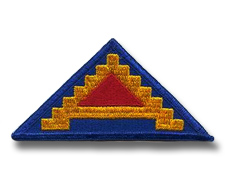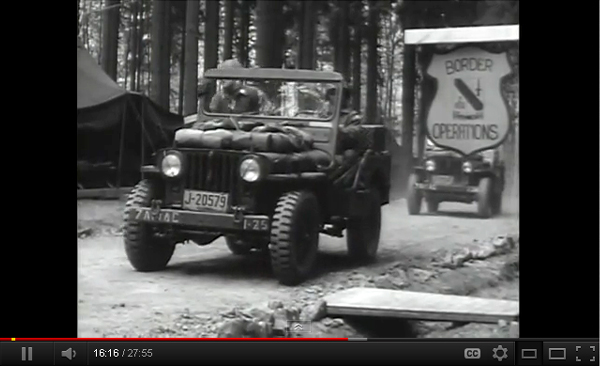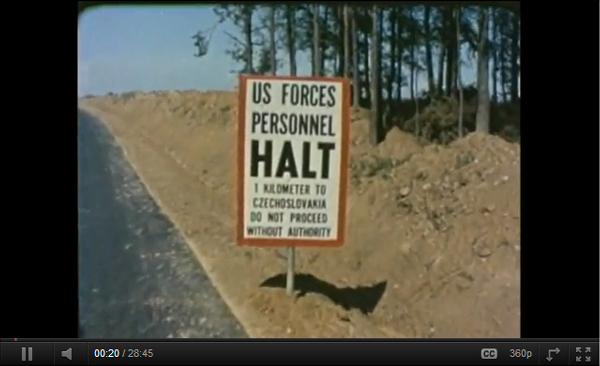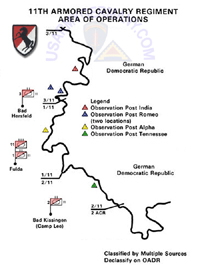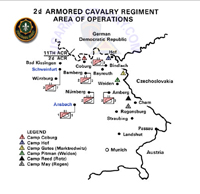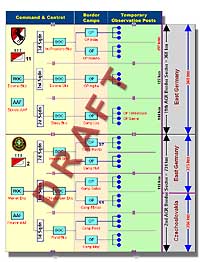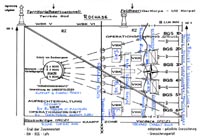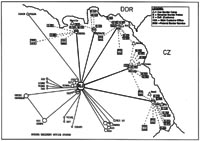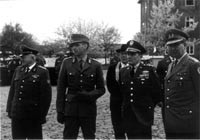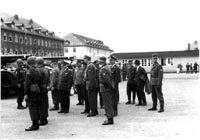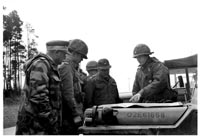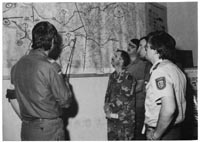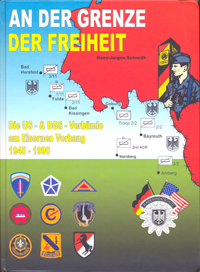| If you do
NOT see the Table of Contents frame to the left of this page, then
Click here to open 'USArmyGermany' frameset |
||||||||||||||||||||||||||||||||||||||||||||||||||||||||||||||||||||
|
Armored
& Cavalry Units |
||||||||||||||||||||||||||||||||||||||||||||||||||||||||||||||||||||
|
|
||||||||||||||||||||||||||||||||||||||||||||||||||||||||||||||||||||
|
||||||||||||||||||||||||||||||||||||||||||||||||||||||||||||||||||||
|
|
||||||||||||||||||||||||||||||||||||||||||||||||||||||||||||||||||||
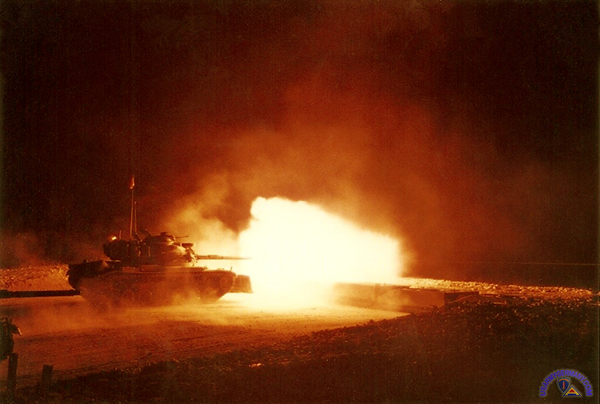 A 1st AD M-60 Patton tank fires a round during night firing from a stationary position at Graf |
||||||||||||||||||||||||||||||||||||||||||||||||||||||||||||||||||||
| The Early Years (1940s & 1950s) | ||||||||||||||||||||||||||||||||||||||||||||||||||||||||||||||||||||
| Early 1950s | ||||||||||||||||||||||||||||||||||||||||||||||||||||||||||||||||||||
| (Source: Dr. Donald A. Carter: "Forging the Shield: The U.S. Army in Europe, 1951 - 1962") | ||||||||||||||||||||||||||||||||||||||||||||||||||||||||||||||||||||
| Excerpts from Chapter 2 - THE NEW MISSION
The three armored cavalry regiments already present in Europe - 2nd ACR at Nürnberg, 6th ACR at Straubing, and 14th ACR at Fulda - occupied forward positions along the boundary between the US and Soviet Zones and along the Czechoslovakia border. They acted as a security screen for V and VII Corps. In the V Corps sector in the north, the 14th Armored Cavalry Regiment patrolled the interzonal boder between Hersfeld and Bamberg, providing the forward screen for the 1st and 4th Infantry Divisions. Farther south, in the VII Corps sector, the 2nd Armored Cavalry Regiment patrolled between Bamberg and Regensburg to the front of the 28th Infantry Division, while the 6th Armored Cavalry Regiment operated between Regensburg and Landshut, in front of the 43rd Infantry Division. In order to strengthen the forward screen and to provide the armored cavalry regiments with some immediately available artillery, Seventh Army assigned a separate armored infantry battalion and field artillery battalion to each regiment. The 373rd Armored Infantry Battalion at Wildflecken and the 631st Armored Field Artillery Battalion at Hammelburg worked with the 14th ACR. The 371st Armored Infantry Battalion and the 70th Armored Field Artillery Battalion, both at Nürnberg, aligned with the 2nd ACR. Further south, the 370th Armored Infantry Battalion at Munich and the 74th Armored Field Artillery Battalion at Landshut went with the 6th ACR. The infantry battalions also provided forward observers and fire support communications networks that were lacking in the armored cavalry regiments. |
||||||||||||||||||||||||||||||||||||||||||||||||||||||||||||||||||||
| 1958 | ||||||||||||||||||||||||||||||||||||||||||||||||||||||||||||||||||||
| (Source: Dr. Donald A. Carter: "Forging the Shield: The U.S. Army in Europe, 1951 - 1962") | ||||||||||||||||||||||||||||||||||||||||||||||||||||||||||||||||||||
| Excerpts from Chapter 8 - SECOND THOUGHTS The pentomic reorganization of the five USAREUR divisions was completed by the beginning of 1958. At that time, Seventh Army consisted of the In the V Corps area, the 14th ACR provided a security screen from Bad Hersfeld in the north to Bad Kissingen in the south for the forward positions of 8th and 10th Infantry Divisions. 3rd Armored Division was in reserve, prepared to reinforce or counterattack. Further south, in the VII Corps area, the 3rd ACR, in the vicinity of Nürnberg, and the 11th ACR in the vicinity of Regensburg and Straubing, patrolled in front of the forward positions of the 11th Airborne Division and the 4th Armored Division. |
||||||||||||||||||||||||||||||||||||||||||||||||||||||||||||||||||||
|
|
||||||||||||||||||||||||||||||||||||||||||||||||||||||||||||||||||||
| The 1960s | ||||||||||||||||||||||||||||||||||||||||||||||||||||||||||||||||||||
| Border Operations | ||||||||||||||||||||||||||||||||||||||||||||||||||||||||||||||||||||
| (Source: US ARMY BORDER OPERATIONS IN GERMANY, 1945-1983, William E.Stacy, HQ USAREUR, 1984) | ||||||||||||||||||||||||||||||||||||||||||||||||||||||||||||||||||||
| At the beginning of the 1960s, three armored cavalry regiments were lined up on the border much as they had been throughout the 1950s. Although the regiments had changed several times, the areas of responsibility and stationing had not been significantly changed during the 1950s. The V Corps area of responsibility in the north was patrolled by the 14th Armored Cavalry Regiment, while the VII Corps areas of responsibility in the center were being patrolled by the 2d Armored Cavalry Regiment and in the south by the 11th Armored Cavalry Regiment. All three armored cavalry regiments were reorganized into the D-series table of organization and equipment (TOE) during May 1960. Major changes were the redesignation of the line companies as troops, battalions as squadrons, and the establishment of regimental aviation companies. This reorganization resulted in shortages in required new equipment and in personnel needed to fill new military occupational specialties (MOS) -- especially in the aviation companies -- that were only beginning to be met at the end of 1960. On 1 October 1960 USAREUR headquarters extended the V Corps area of responsibility for border surveillance north to include the German III Corps sector (Hebenshausen, NB 6494, to Blankenbach, NB 7252 [1]). The already overstretched 14th Armored Cavalry Regiment assumed this additional area, and when negotiations to pass it on to the Belgians were terminated in 1963, it became a permanent V Corps responsibility. [1] This area had formerly been patrolled by V Corps units, but was transferred to the Germans in 1957. However, because the Bundeswehr was not allowed to patrol on the border and had to rely on BGS and Zoll coverage, the sector was perceived to be a "gap" between CENTAG and NORTHAG border coverages. The 2d Squadron of the 2d Armored Cavalry Regiment had been attached to the 14th Armored Cavalry Regiment for border operations since April 1959. As a consequence, the squadron commander received orders from four separate commands -- both cavalry regiments and two different Area Commands. In 1960 the 2d Armored Cavalry Regiment's commander recommended that the V and VII Corps boundaries be revised so that the squadron could be returned to its parent organization. The boundary was shifted in 1961, but further north than anticipated so that the new corps boundary coincided with the dividing point between two of the 14th Armored Cavalry Regiment's squadrons rather than between the two regiments. Concurrent with the implementation of the revised emergency defense plan (EDP 1-61) on 1 December 1961 the 2d Squadron of the 2d ACR was returned to the control of its parent unit; however, the 2d Squadron of the 14th ACR would now be attached to the 2d ACR for border operations, thus continuing the confused command arrangement with a reverse twist. The revision, although somewhat unwieldy for peacetime border operations, was supposed to make for a more rational wartime posture. [2] There were indications in unit histories that the 14th ACR received help with its border surveillance mission from other cavalry elements in the command, particularly from the 3d ACR, which had reconnaissance troops attached to the 3d Squadron of the 14th ACR on a rotating basis. [2] In 1967 the 2d ACR would be even more undermanned on the border, having lost its add-on cavalry elements to the south (2nd Sq of the 9th Cav), and was given administrative control of the 2d Squadron of the 14th ACR, effective 1 February 1967. (USAREUR GO 28, 1 Feb 67.) In May 1963 Department of the Army directed the return or inactivation of the Roundout units. During the latter part of the year, USAREUR received approval for retaining the 3d Armored Cavalry Regiment and sending the 11th Armored Cavalry Regiment to the United States instead. In July 1964, the 1st Squadron of the 11th ACR remained in place (Straubing) and, in a flag switch on 10 June, was redesignating as the 2d Squadron of the 3d ACR. Also on 10 June the 2d ACR assumed responsibility for the complete VII Corps peacetime border surveillance mission, with operational control for border operations of the 2d Squadron of the 3d ACR. The 2d ACR also still had operational control for border operations of the 2d Squadron of the 14th ACR at this point The 2d Squadron of the 3d ACR remained in place until 1 March 1965, when its peacetime border surveillance mission was assumed by the 2d Squadron of the 9th Cavalry, which belonged to the 24th Infantry Division. As had been the 2d Squadron of the 3d ACR, the 2d Squadron of the 9th Cavalry was under the operational control of the 2d ACR for border operations and patrolled between coordinates UQ 2590 and VQ 1403. Actually, the border surveillance of this section was carried out by reinforced troops from the 2d Squadron of the 9th Cavalry, sent up to the border on a rotating basis. The French Forces in Germany headquarters had offered in 1959 to augment the USAREUR peacetime border surveillance mission with a cavalry platoon. USAREUR accepted the offer, and in January 1960 a cavalry platoon from the 5th Regiment of Hussars was attached to the 11th ACR to assist with its surveillance of the southern section of the Czechoslovak-FRG border. On 1 February 1962 a platoon of the 24th Regiment of Spahis began alternating with the 5th Hussar's platoon every four months at the US border camp at Roehrnbach. On 4 July 1966 -- concurrent with the withdrawal of French forces from NATO -- the French Forces in Germany headquarters informed USAREUR that it would terminate its limited participation in peacetime border surveillance operations. The French platoon withdrew from border patrolling on 15 July 1966, and the 2d Squadron of the 9th Cavalry added the French sector to its own. The rest of the decade was a period of austerity during which the two armored cavalry regiments, with the aid of various USAREUR cavalry elements, tried to adjust to covering a border that had been patrolled by three regiments. When USAREUR implemented Plan JAYHAWK on 1 March 1967, the 2d Squadron of the 9th Cavalry was removed from border operations and returned to the control of its parent unit, leaving the 2d ACR with even fewer resources to accomplish the VII Corps border surveillance mission. Although the 2d ACR had been given complete operational control of the 2d Squadron of the 14th ACR on 1 February 1967 -- it already had operational control for border operations -- this hardly made up for the loss of the 9th Cavalry since the 2d ACR was already utilizing the 2d Squadron of the 14th ACR in its sector. With the withdrawal of the 3d Armored Cavalry Regiment from USAREUR as part of the REFORGER program during May through July 1968, the command now utilized only two armored cavalry regiments -- without any full-time supplementation by other cavalry elements -- to perform the entire CENTAG border surveillance mission. By the end of the decade, the command was studying ways to utilize divisional cavalry elements on the border in order to relieve the two regiments during training at major training areas; however, from this point on it was primarily their responsibility to conduct the peacetime border surveillance mission. The stationing between the two regiments differed in that the 2d ACR tended to operate out of forward border camps, while the 14th ACR operated out of squadron locations, moving up to observation posts for their tours of border duty. This reflected, in part, the longer length of the 2d ACR's border sector and the proximity of the 14th ACR s squadron locations to the border. The 14th ACR's two remaining squadrons were located at Fulda (1st Squadron as well as the regimental headquarters) and at Bad Hersfeld (3d Squadron). It operated four permanent observation posts, including a new one added in 1970 at NB 6492 (OP-Oscar) to cover the Nordhausen-Witzenhausen approach into the Hessian corridor. (It became operational on 1 January 1971.) There were no references to the exact location of the other three observation posts, but in all likelihood they were located in the same places as India (NB 802585), Romeo (NB 694457), and Alpha (NB 658198) were in the 1970s. The 2d Squadron of the 14th ACR, which was under the operational control of the 2d ACR, was headquartered at Bad Kissingen and operated out of Border Camp Wollbach (NA 8780). The other 2d ACR squadrons operated out of the following locations: Headquarters, 2d ACR - Nuernberg The border camp at Roehrnbach was closed after the French terminated their border patrols. |
||||||||||||||||||||||||||||||||||||||||||||||||||||||||||||||||||||
| ACR Organization | ||||||||||||||||||||||||||||||||||||||||||||||||||||||||||||||||||||
| It might be useful at this point to review the basic structure of the armored cavalry regiments and their stationing on the border. Each armored cavalry regiment; in accordance with TOE 17-51D, consisted of a headquarters and headquarters company, an aviation company, and three armored cavalry squadrons. Each armored cavalry squadron of the regiment, in turn, consisted of a headquarters and headquarters troop, one tank troop, three armored cavalry troops, and one 155-mm howitzer battery. Finally each armored cavalry troop consisted of three platoons, with each platoon having three tanks it should be noted that the divisions had similar armored cavalry squadrons CORRECTIONS (Source: Email from Nelson Voke, 3rd Squadron, 2nd ACR, 1962-65) In your site’s section on Border Operations/The 1960’s/ACR Organization, you close with “…armored cavalry troop consisted of three platoons, with each platoon having three tanks…”. Someone might construe this as meaning a cavalry platoon had only three vehicles (all tanks), versus the five tanks of a tank platoon. Of course, our cavalry platoons had ten vehicles: an M-151 for the platoon leader, four M-151’s for the scout section, three tanks in the tank section, an M-113 for the infantry section, and the track for the 4.2” mortar. During my tour the M-151’s were replaced by M-114’s and M-114A1’s. |
||||||||||||||||||||||||||||||||||||||||||||||||||||||||||||||||||||
|
|
||||||||||||||||||||||||||||||||||||||||||||||||||||||||||||||||||||
| The 1970s | ||||||||||||||||||||||||||||||||||||||||||||||||||||||||||||||||||||
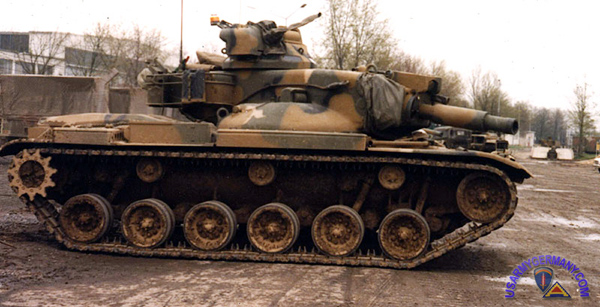 M60A2 of 2nd Bn, 64th Arm at Conn Barracks, Schweinfurt |
||||||||||||||||||||||||||||||||||||||||||||||||||||||||||||||||||||
| M-60A2 "Starship" - "A-Deuce" | ||||||||||||||||||||||||||||||||||||||||||||||||||||||||||||||||||||
| 1975 | ||||||||||||||||||||||||||||||||||||||||||||||||||||||||||||||||||||
| (Source: STARS & STRIPES, June 28, 1975) | ||||||||||||||||||||||||||||||||||||||||||||||||||||||||||||||||||||
| 1st Bn, 32nd Arm is the first of six USAREUR battalions to transition to the M60A2 tank. The first company to receive the tanks was Co B, 1-32nd Arm. Each tank company will receive 17 M60A2 tanks; each armor battalion will have a complement of 54 tanks. Some divisions in USAREUR will have two battalions equipped with the M60A2 (Webmaster note: 3rd Armd Div and 3rd Inf Div each appear to have ended up with two M60A2 battalions), others will have only one battalion (1). The M60A2 went into production in 1972 (after several years of delays due to the many problems encountered in the initial testing program in 1968.) 540 vehicles have been built. The tanks are being issued to the troops at the Combined Arms School at Vilseck. A maintenance crew from the Armor Branch of the School and a team of experts (M60A2 New Equipment Training Team) from Ft. Knox, Ky are involved in the fielding process, preparing the new tanks prior to issue to the troops. The first eight M60A2 tanks arrived at CAS in February 1975. The M60A2 issue program will be completed in 18 months. Each tank company receiving the new tank will receive four weeks of instruction at the School on crew operations and gunnery, as well as on maintenance. The training will include the firing by each four-man crew of a modified tank gunnery program. Each tank crew will have an instructor from CAS attached to it throughout the four week training period. The M60A2 tank is manufactured by the Continental Motors Corp. The tank fires a 152-mm conventional round or the Shillelagh missile. The M60A2 is equipped with night vision devices, an electronic fire control computer and a laser range finder. The turret is stabilized in azimuth and main gun, along with the 7.62-mm coaxial M73 machine gun. (Accoring to the experts from the new equipment training team, the laser range finder gives the tank crew the ability to range out to 4,000 meters with an accuracy of plus or minus 10 meters. The first-round hit capability is 99.8 percent out to 4,000 meters.) The M60A2 combat load of 152-mm conventional ammunition is 33 HE anti-tank or cannister rounds and 13 missiles. The addition of the missile-firing tank is seen as a significant enhancement of Seventh Army's tank fleet by improving the accuracy of hitting and killing enemy tanks at greater ranges. |
||||||||||||||||||||||||||||||||||||||||||||||||||||||||||||||||||||
| USAREUR Units Equipped With the M60A2 in 1975/1976: | ||||||||||||||||||||||||||||||||||||||||||||||||||||||||||||||||||||
|
||||||||||||||||||||||||||||||||||||||||||||||||||||||||||||||||||||
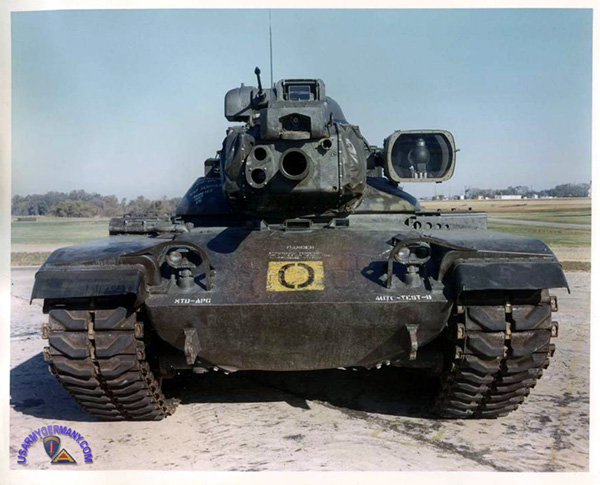 An M60A2, probably during trials at Aberdeen Proving Ground (US Army) |
||||||||||||||||||||||||||||||||||||||||||||||||||||||||||||||||||||
| ADDITIONAL M60A2 ARTICLES -- 1st Bn, 37th Arm, July 1976 |
||||||||||||||||||||||||||||||||||||||||||||||||||||||||||||||||||||
| MISCELLANEOUS INFORMATION: (1) I have found information that indicates that at least some of the M60A2 tank battalions were later reorganized to mixed units: with one or two companies equipped with the M60A2 and the other(s) with M60A1s. Can anyone provide any details? |
||||||||||||||||||||||||||||||||||||||||||||||||||||||||||||||||||||
|
|
||||||||||||||||||||||||||||||||||||||||||||||||||||||||||||||||||||
| The 1980s | ||||||||||||||||||||||||||||||||||||||||||||||||||||||||||||||||||||
| Border Operations | ||||||||||||||||||||||||||||||||||||||||||||||||||||||||||||||||||||
| (Source: US ARMY BORDER OPERATIONS IN GERMANY, 1945-1983, William E.Stacy, HQ USAREUR, 1984) | ||||||||||||||||||||||||||||||||||||||||||||||||||||||||||||||||||||
In 1983 the 11th Armored Cavalry Regiment, with headquarters in Fulda (Downs Barracks), divided up the V Corps' border sector as follows, from north to south (see Map 1): |
||||||||||||||||||||||||||||||||||||||||||||||||||||||||||||||||||||
|
||||||||||||||||||||||||||||||||||||||||||||||||||||||||||||||||||||
- The regiment also had a Combat Aviation Squadron (formerly called the Command and Control Squadron), which among other things included the air troop and support troop (air) elements mentioned above and was located,at Fulda. It had the task of providing regimental aerial surveillance along the entire V Corps' sector. - In addition, the 3d Squadron of the 12th Cavalry, which belonged to the 3d Armored Division, and the 3d Squadron of the 8th Cavalry, which belonged to the 8th Infantry Division, conducted border operations when 11th ACR units were training or needed augmentation. |
||||||||||||||||||||||||||||||||||||||||||||||||||||||||||||||||||||
The 2d Armored Cavalry Regiment, with headquarters at Nuernberg (Merrell Barracks), conducted border operations in the VII Corps' sector as follows, from north to south (see Map 2): |
||||||||||||||||||||||||||||||||||||||||||||||||||||||||||||||||||||
|
||||||||||||||||||||||||||||||||||||||||||||||||||||||||||||||||||||
- The 1st Squadron of the 1st Cavalry (1st Armored Division) had been placed under the operational control of the 2d ACR for border operations only in November 1978 and was responsible for the border sector from UR 140426 to UQ 293890. It operated out of Camp Pitman (TR 937064). (Camp Weiden was renamed Camp Pitman.) - The 3d Squadron of the 2d ACR was headquartered at Amberg (Pond Barracks) and operated out of Camp Reed (UQ 183658) (Camp Rotz was renamed Camp Reed) and Camp May (UQ 584281). It was responsible for the border sector from UQ 293890 to VQ 148029. - Early in the 1970s, Camp Wollbach and Camp Phillipsreut had been used in the VII Corps sector, but by 1974 they were no longer listed as active border camps. - The 2d ACR also had a Command and Control Squadron (Provisional), which included the air troop and support troop (air) that accomplished the regimental serial surveillance mission as well as other regimental elements and was stationed at Merrell Barracks and Feucht Army Airfield in Nuernberg. The air troop, designated Attack Helicopter Troop, conducted surveillance in the Weiden and Regen sectors, while the support troop (air), designated Support Helicopter Troop, had responsibility for the Hof and Coburg sectors. |
||||||||||||||||||||||||||||||||||||||||||||||||||||||||||||||||||||
| (Source: ABOUT TOWN, May 5, 1982) | ||||||||||||||||||||||||||||||||||||||||||||||||||||||||||||||||||||
| 2nd Squadron,
11th Armored Cavary Regiment
- is responsible for patrolling 144 km of the East/West border near
Bad Kissingen. The Camp Phillip L. Lee, "Eaglehorse Forward," serves as the base for the 2nd Sqdn's border patrol. The 2nd Sqdn is based in Bad Kissingen. Units rotate to Camp Lee for two to four weeks of border patrol duty. The entire section must be patrolled at least every 72 hours. |
||||||||||||||||||||||||||||||||||||||||||||||||||||||||||||||||||||
|
||||||||||||||||||||||||||||||||||||||||||||||||||||||||||||||||||||
|
|
||||||||||||||||||||||||||||||||||||||||||||||||||||||||||||||||||||
| Bundesgrenzschutz and other German border patrol agencies | ||||||||||||||||||||||||||||||||||||||||||||||||||||||||||||||||||||
| (Source: Chapter Four, US ARMY BORDER OPERATIONS IN GERMANY, 1945-1983, by William E. Stacy) | ||||||||||||||||||||||||||||||||||||||||||||||||||||||||||||||||||||
|
German Control
of the Border |
||||||||||||||||||||||||||||||||||||||||||||||||||||||||||||||||||||
|
||||||||||||||||||||||||||||||||||||||||||||||||||||||||||||||||||||
|
||||||||||||||||||||||||||||||||||||||||||||||||||||||||||||||||||||
|
||||||||||||||||||||||||||||||||||||||||||||||||||||||||||||||||||||
|
|
||||||||||||||||||||||||||||||||||||||||||||||||||||||||||||||||||||
| Related Links: Grenzer.com - a wonderful web site devoted to the history of the Iron Curtain and the soldiers on both sides of the border who patrolled it. Point Alpha - The Point Alpha Association association maintains “Observation Point Alpha” at Rasdorf and parts of the former GDR border fortifications in the Thuringia region as an memorial to the former division of Germany as well as the Cold War. Eaglehorse.org - a wonderful web site that presents in much detail and in a very professional manner the history of the 11th Armored Cavalry Regiment in Germany and the border surveillance mission. Site is managed by Robert Stefanowicz and Randy Mitchell. 3rd Armored Cavalry Regiment - official website at Fort Hood, TX |
||||||||||||||||||||||||||||||||||||||||||||||||||||||||||||||||||||
|
||||||||||||||||||||||||||||||||||||||||||||||||||||||||||||||||||||
